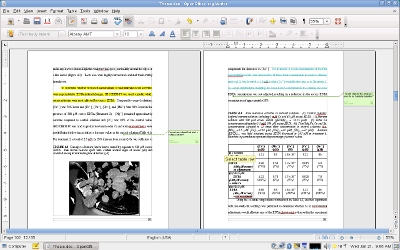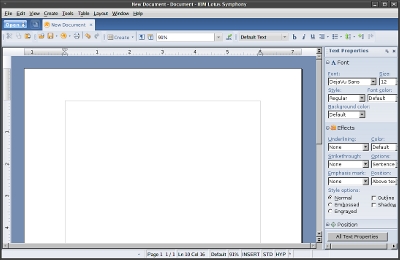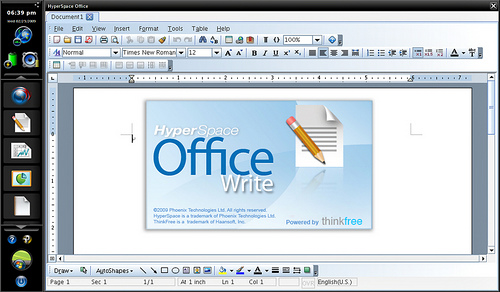Neither Lotus nor Novell are strangers to word processing, of course. But with IBM Lotus Symphony and Novell office suites, the vendors have made their first forays into Linux word processors, a space also occupied by dozens of rivals, ranging from Sun to large numbers of small .orgs. In the same general vein as StarOffice, Sun’s commercial edition of OpenOffice.org, Lotus’ and Novell’s suites for Linux and other operating systems feature word processing solutions based on OpenOffice.org‘s Writer.
If you’re interested in OpenOffice, why bother to use a big vendor’s rendition when the community edition is so readily available, both over the Web and bundled with netbooks? Well, Novell’s version of OpenOffice–available for Linux as part of SuSE Linux and on a standalone basis for Windows–contains features not built into the community edition. In line with Novell’s multi-year interoperability deal with Microsoft, many of these capabilities are geared to Microsoft Office compatibility.
IBM Lotus Symphony, on the other hand, offers a user interface (UI) widely regarded as simpler and nicer looking than that of OpenOffice.org. Symphony is also strongly integrated with Notes and other Lotus products, although a standalone edition is also available for all three supported platforms: Linux, Windows, and Mac OS X.
For its part, Moblin is not an office suite but an entire software environment, specifically tailored to netbooks and other embedded devices. Over the past few months, both Novell and Phoenix Technologies have issued promising announcements around Moblin.
OpenOffice.org Novell Edition
Runs on Linux and Windows
 Novell and Lotus first ventured into word processing software a long time ago, albeit through different avenues. Back in 1994. Novell bought WordPerfect Inc.,and then quickly proceeded to use the acquired company’s word processing software as the linchpin for its multiplatform GroupWise software suite. Although most of Novell’s WordPerfect products were sold to Corel in 1996, Novell continues to produce GroupWise, a suite that ultimately became focused on collaboration and messaging instead of word processing.
Novell and Lotus first ventured into word processing software a long time ago, albeit through different avenues. Back in 1994. Novell bought WordPerfect Inc.,and then quickly proceeded to use the acquired company’s word processing software as the linchpin for its multiplatform GroupWise software suite. Although most of Novell’s WordPerfect products were sold to Corel in 1996, Novell continues to produce GroupWise, a suite that ultimately became focused on collaboration and messaging instead of word processing.
Fast-forwarding ahead to Novell’s current release of OpenOffice, Novell’s software incorporates the same five applications as the community edition: Writer; the Calc spreadsheet; the Impress presentation package; the Base database; and the Draw graphics package.
But in conjunction with the rollouts of the Windows edition and SLED 11, Novell licensed fonts from AGFA which use the same or similar names to those available in MS Office. These fonts are also geometrically similar to those used in the Microsoft software, a move seen by Novell as enabling very close matches in pagination and page formatting.
Novell has also backported a number of fixes for improved file sharing with MS Office, including full conversion of embedded objects and improved compatibilty with Microsoft Excel spreadsheet functions.
In other points of distinction, the Novell edition supports import of WordPerfect files and scalable vendor graphics. Support for the OOXML files used in MS Office 2007, first introduced in the community edition last October, is also present.
On the Linux side, SLED 11 also incorporates enhancements around Windows interoperability introduced earlier with prior versions of OpenSUSE, including support for the Microsoft .NET API through Mono and initial Silverlight and Microsoft WMA support through Moonlight 1.0. SLED 11 is priced at $120.
IBM Lotus Symphony
Runs on Linux, Windows, and MacOS X
 About six years before its own buyout by IBM in 1995, Lotus stepped into word processing with Ami Pro. Obtained by Lotus through its own acquisition of a start-up named Samna, Ami Pro later became a staple in the SmartSuite office suite, a long-time competitor to MS Office.
About six years before its own buyout by IBM in 1995, Lotus stepped into word processing with Ami Pro. Obtained by Lotus through its own acquisition of a start-up named Samna, Ami Pro later became a staple in the SmartSuite office suite, a long-time competitor to MS Office.
Known for its slick UI, IBM Lotus Symphony, launched in 2007, comes as a standalone edition, as well as an embedded version which is integrated into Notes, Foundation, iNotes, and other Lotus software.
The Lotus suite includes Documents, Presentation, and Spreadsheet applications. Unlike OpenOffice and StarOffice, it does not encompass a database or drawing package. But all three of Symphony’s apps are readily accessible from a single screen.
Done up in an elegant blue-gray color scheme, Symphony’s UI offers intuitive menus and icons. Text Properties and other options are easily available through a panel across the right-hand side.
Symphony’s Documents word processor offers features such as templates; pre-defined styles for paragraphs, characters, and headings; inline spell checking and correction; and automatic creation of tables of contents, footnotes, indexes, and footers and headers.
Macros are included, too. But IBM freely acknowledges on its Web site that Symphony’s macros cannot be exported into Microsoft Office, and that Microsoft Office macros can’t be imported into Symphony, either.
Document and the other Symphony apps support a wide variety of Microsoft and SmartSuite file formats, along with export to Adobe PDF. In an update released in July of this year, IBM added import of MS Office 2007 OOXML files.
But at this point, anyhow, you might not want to try running Symphony on a netbook, since it’s kind of demanding on system resources, requiring at least 750MB of free disk space on Linux and at least 540BM on either Windows or Mac, plus at least 512MB of RAM memory regardless of OS.
Symphony downloads are free of charge–although unlike the Novell software, Symphony is offered under a proprietary as opposed to an open source license. Support and maintenance for Symphony is available from IBM Lotus, but the pricing is oriented to large organizations.
¬†A contract for the standalone edition covering up to 25,000 end users goes for a flat fee of $25,000. (By the way, in contrast to the software from IBM Lotus and Novell, Sun’s competing StarOffice is not free. Sun charges $50 per individual download of StarOffice. But that price includes tech support for three incidents within 60 days, plus proprietary software components in StarOffice running the gamut from clip art libraries to StarOffice Configuration Manager.)
HyperSpace Office
Runs on Moblin
 Still in the early phases of development, Moblin has been available to PC makers as well as for end user downloads since earlier this year. Version 2 of the Linux-based software for Intel Atom-based devices includes uses a Fedora Linux framework and Gnome for its desktop and applications. Its word processor is GNOME’s somewhat limited Gedit.
Still in the early phases of development, Moblin has been available to PC makers as well as for end user downloads since earlier this year. Version 2 of the Linux-based software for Intel Atom-based devices includes uses a Fedora Linux framework and Gnome for its desktop and applications. Its word processor is GNOME’s somewhat limited Gedit.
In April of this year, however, the Linux Foundation announced intentions to host and support Moblin. In May, Novell unveiled plans to build a Moblin-based product that it will take to market to hardware manufacturers. Then in July, Phoenix Systems announced that it will align and combine Moblin with HyperSpace, its own instant-on mobile environment for Linux.
HyperSpace now includes HyperSpace Office, a software suite containing word processing, spreadsheet and presentation applications expressly created for mobile devices.
Next in the Hopper
All of the commercial and open source word processors we’ve discussed in this series run on top of the Linux OS, and some are available for Windows, Mac OS, and other OS. On the other hand, some of the word processors out there today–included in online suites such as Google Apps and ZoHo–are Web-based.
What are the pros and cons of these so-called online word processors, and how do they compare? In a future article, we’ll delve into those questions.

